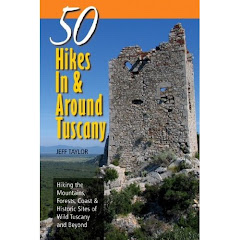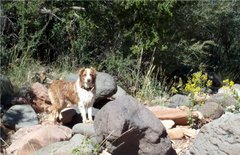Distance: 1.8 miles (2.9 km)
Elevation: 5,100-5,200 feet (1555 - 1585 m)
Difficulty: Moderately Easy
Time of Year: Any Time (avoid heat of mid-summer and icy conditions in winter)
The Granite Dells area near Prescott, AZ is a beautiful area of smooth granite formations, lush green riparian ecosystems, and stunning vistas just outside of the city of Prescott in the Central Highlands. This easy hike through these features makes this a perfect place to stretch your legs a little if you happen to be in town. Half of the trail goes directly over the granite formation, until you reach Watson Lake Dam, and then it returns following the stream in a riparian forest canyon along the "Flume Trail". In addition, very nearby there is a city park along a reservoir called Watson Lake that offers camping for out-of-towners.
To access this trail, take Hwy-89 north out of Prescott and look for Granite Dells Road to the right. Drive down this for 0.3 miles to a parking area to the right in-and-amongst the granite boulders. The trail starts out in a narrow notch in the rocks before emerging into an open area that crosses between the yards of two homes. Then, shortly thereafter the trail branches with the right fork heading upslope. Take this turn to the right.
The trail wanders over and across beautiful granite formations, as it heads south toward Watson Lake. Off to the west you will see 7626 foot Granite Mountain rising above the landscape. This is located in a national forest wilderness area and will be the feature of a future hike description soon. Look for a variety of high desert plants along this hike including the beautiful red flowers of the claret cup cactus, as well as, yucca, scrub live oak, and pinyon pines.
Eventually, you will get your first glimpse of the dam and reservoir. If you camp at Watson Lake Park, you will have other opportunities to boulder-hop near it's shores. Soon thereafter you will descend down to the creek bottom and end up at the base of the dam.
Here, water plunges out of an opening in the middle of the dam filling the canyon bottom with the water that sustains a lush riparian strip of cottonwoods, sycamores, ash, and willows. The trail turns and heads downstream on the left side of the creek. But, there is a side trail that crosses the creek and ascends the otherside called "Over-The-Hill Trail" for obvious reasons. It climbs out of the canyon and over the hill to the otherside for additional views of the surrounding landscape. By using other nearby trails such as sections of the Lakeshore Trail, Peavine Trail, and Storm Ranch Road, it is possible to make a larger loop. But, to take it easy, just continue downstream on the Flume Trail.
After a brief climb over a large rocky section, the Flume Trail leisurely follows the canyon a dozen meters above the stream, at the edge of the lush riparian forest. The trail will eventually reconnect with the main trail at the junction you noticed earlier and you can just follow this back to the car.
Be aware that despite hiking at over 5,000 feet the temperatures routinely exceed 90 degrees in summer and ice or snow can cover the shadowy areas in winter. The best time of year to hike in this region are during the dry and warm periods from March to May and in spectacularly beautiful October when the leaves are changing colors!














































